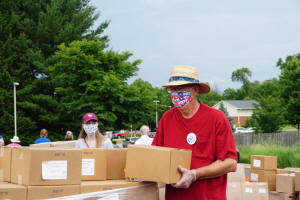Food banks worry about donor fatigue as pandemic continues
 Send a link to a friend
Send a link to a friend
 [August 26, 2021]
By Scot Bertram [August 26, 2021]
By Scot Bertram
(The Center Square) – Requests for food
assistance during the ongoing pandemic continue to put pressure on
Illinois food banks.
Julie Yurko, president and CEO of Northern Illinois Food Bank, praised
the community response over the past 18 months, but still worries about
donor fatigue.
“My biggest concern is actually the food,” Yurko said. “Our donated food
is down. The supply chain has been greatly disrupted. The government had
stepped in and was providing more food to us, but we're not getting
nearly the level of government food that we've gotten over the last 18
months. And so we are concerned.”
She says government programs, many included in the American Rescue Plan
Act, have had a positive impact, helping to reduce food insecurity in
local communities. However, some of those assistance efforts soon are
scheduled to come to an end.
“It'll be curious to see what happens in Washington,” Yurko said. “For
example, our SNAP Pandemic EBT is supposed to end on September 5th here
in Illinois, and that will affect more than 850,000 of our kids. If that
happens, we are ready to help those families.”

Yurko says it’s too early to determine if the advance Child Tax Credit
payments, which began in July, will have an impact on demand.
Meanwhile, an announcement this week by the Biden administration means a
permanent increase in food stamp assistance available to families.
Starting in October, average benefits for the SNAP program will rise
more than 25% above pre-pandemic levels.
Molly Delaney, vice president of development at Eastern Illinois
Foodbank, shares Yurko’s concerns regarding the continued need for
support for the organization’s efforts.
“I will say that we are already seeing a drop in donations in August,”
Delaney said. “The need is still out there and we're just hoping that
people's focus won't change as we go into the months and years ahead."
[to top of second column]
|

Work underway at Northern
Illinois Food Bank.
Courtesy of Northern Illinois Food Bank

According to recent data, the Eastern Illinois Foodbank provided food to
more than 350,000 people last year, a jump of about 11% from
pre-pandemic levels.
“It was really kind of up and down, depending on what area people were
in and the population that they serve,” Delaney said. “There was
definitely an increase in people that were seeking food for the first
time. We saw that about 30% of the folks that were being served with new
clients.”
Eastern Illinois Foodbank serves an 18-county area covering about 14,500
square miles of the state. Over the past year, the organization has
distributed 9.75 million meals to the community.
Both Yurko and Delaney agree a full recovery is years away.
“We do look at the recession of 2008,” Yurko said. “It took us three
years before food insecurity returned to expected levels in our service
area. We are expecting it will take two full years before the demand for
food assistance returns to our pre-pandemic levels.”
She said the rural regions of Northern Illinois Food Bank’s 13-county
area have been the toughest to serve, due to fewer points of
distribution and a lower population density.
“We all need some help every once in a while,” Yurko said. “If someone
needs some help, we have beautiful, nutritious, fresh groceries. We have
over 900 feeding sites. Please come to us. We will provide you with the
groceries you need for as long as you need them.”
 |